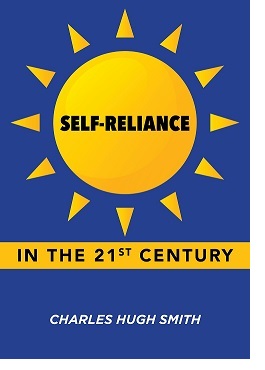We can all pretend to be fantastic until the floor collapses beneath us. At that point, complacency / denial gives way to panic, but it’s too late to effect any realistic reversal of fortune.
Doom Loops have been in the lexicon a long time. The basic idea is the decline of one of the inputs holding up the status quo weakens the other inputs. This weakness feeds back on itself, accelerating the decline until a critical support level breaks and the system collapses.
Doom Loops are being used to describe big-city downtowns gutted by remote work, the closure of small businesses and the rise of property crime and chronic homelessness. Once the workforce commuting to downtown fell sharply, the businesses catering to this workforce no longer had a customer base large enough to support them all and so many close.
This mass closure makes the district less vibrant, further weakening commerce.
At the same time, politicians and district attorneys have mandated non-prosecution of non-violent property crimes such as auto break-ins, shoplifting, etc., giving the green light to the criminal class that specializes in property crimes. This increase in property crime forces the closure of flagship retail outlets stripmined by blatant shoplifting.
This shift in enforcement did little to stem the flood of fentanyl and other addictive narcotics into city centers, where the chronic homeless have congregated in sprawling encampments.
While mayors promote declines in violent crimes, they don’t mention the impact of human waste, drug-addled homeless and property crimes, many of which are not even reported as small business owners fear reporting losses due to break-ins might result in their insurance policies being cancelled.
The closures of downtown businesses cause tax revenues to plummet, leaving less for policing and other essential services. Criminals quickly catch on and so break-ins occur when police patrols are absent.
Meanwhile, the decline in commuters has crushed transit agencies’ revenues, creating giant holes in billion-dollar budgets with few realistic solutions.
The solution being touted is to convert empty office buildings into residences, to replace commuting office workers with residents. This sounds feasible in the abstract, but these conversions are extremely costly, and the attractiveness of decaying downtowns to upscale residents is a question few entertain, for the answer is painfully obvious: who wants to live in a neighborhood of human waste, degradation, rampant property crimes and drugs, all of which have rendered local businesses unviable?
You can be sure the politicians and DAs whose policies exacerbated the decay won’t live downtown. Like the people who elected them, they live in wealthy enclaves that are so far protected from the consequences of doom loops.
Once the downtown has been stripped of targets, do you reckon the criminals who specialize in property crimes will retire? Or will they move into the enclaves where the protected class lives?
Another doom loop is gutting rural villages and towns globally. You’ve probably seen media reports of houses in Italian or Japanese villages that can be had for $1 or some nominal sum, for example:
Why Japan is Giving Away 8 Million Free Houses (13 min) (via J.F.). Note: the 8-million number is click-bait.
Left out of these chirpy accounts of $1 houses in charming villages are all the realities that generated the doom loop that hollowed out the villages in the first place: their remoteness, absence of jobs, the dominance of an aging populace of pensioners, decaying, outdated housing requiring costly renovations, the depreciating value of such properties, and so on.
Once the post office closes due to a decline in the populace and the elementary school closes due to a decline in enrollment, the village is doomed. Families with children move away, further reducing the populace, pushing it below the thresholds needed to support a local temple/church priest, a local cafe, etc.
Doom Loops are difficult to reverse. The current zeitgeist, which seems to only have two poles, complacency / denial and panic, is not conducive to practical, realistic appraisals or plans of action, all of which require painful sacrifices and reductions in unsustainable spending to align with reduced revenues and prospects.
This zeitgeist encourages “positive optics” and happy stories disconnected from the realities of the doom loops already in play. Yes, we can all pretend to be fantastic until the floor collapses beneath us. At that point, complacency / denial gives way to panic, but it’s too late to effect any realistic reversal of fortune.

New Podcast:
Its a Waterfall – Risk, Collateral & Productivity (48 min)
My new book is now available at a 10% discount ($8.95 ebook, $18 print):
Self-Reliance in the 21st Century.
Read the first chapter for free (PDF)
Read excerpts of all three chapters
Podcast with Richard Bonugli: Self Reliance in the 21st Century (43 min)
My recent books:
The Asian Heroine Who Seduced Me
(Novel) print $10.95,
Kindle $6.95
Read an excerpt for free (PDF)
When You Can’t Go On: Burnout, Reckoning and Renewal
$18 print, $8.95 Kindle ebook;
audiobook
Read the first section for free (PDF)
Global Crisis, National Renewal: A (Revolutionary) Grand Strategy for the United States
(Kindle $9.95, print $24, audiobook)
Read Chapter One for free (PDF).
A Hacker’s Teleology: Sharing the Wealth of Our Shrinking Planet
(Kindle $8.95, print $20,
audiobook $17.46)
Read the first section for free (PDF).
Will You Be Richer or Poorer?: Profit, Power, and AI in a Traumatized World
(Kindle $5, print $10, audiobook)
Read the first section for free (PDF).
The Adventures of the Consulting Philosopher: The Disappearance of Drake (Novel)
$4.95 Kindle, $10.95 print);
read the first chapters
for free (PDF)
Money and Work Unchained $6.95 Kindle, $15 print)
Read the first section for free
Become
a $1/month patron of my work via patreon.com.
NOTE: Contributions/subscriptions are acknowledged in the order received. Your name and email
remain confidential and will not be given to any other individual, company or agency.
| Thank you, Terry M. ($25), for your much-appreciated generous contribution to this site — I am greatly honored by your steadfast support and readership. |
Thank you, Dirk L. ($50), for your superbly generous contribution to this site — I am greatly honored by your support and readership. |
| Thank you, Do E. ($50), for yet another splendidly generous contribution to this site — I am greatly honored by your support and readership. |
Thank you, Ken B. ($50), for your marvelously generous contribution to this site — I am greatly honored by your steadfast support and readership. |

